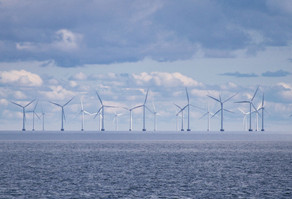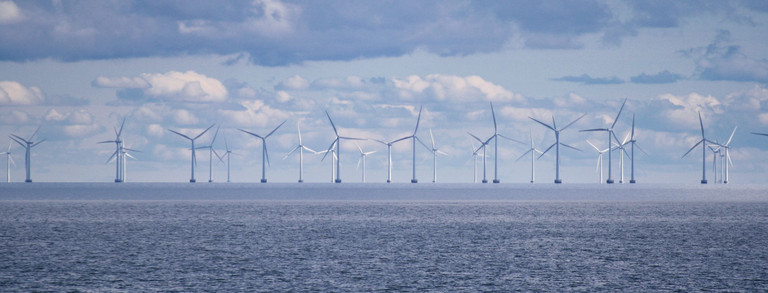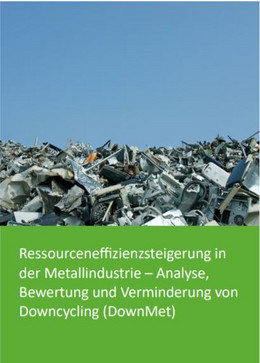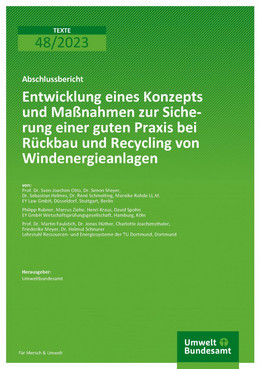Research projects
Ongoing research projects
Over the past three years, numerous large cities in Germany in particular, as well as rural districts, have developed strategies to achieve climate neutrality on their territory.
The implementation of these climate neutrality strategies is now imminent and it is already becoming apparent that the existing administrative structures and organizational framework conditions (in particular the coordination offices for climate protection located within the city administration) are not having the required effect - which can be influenced by the municipality - both in terms of quantity (significant greenhouse gas savings in cooperation with the city community) and in terms of the number of measures that can be implemented.
- in terms of quantity (considerable greenhouse gas savings in cooperation with the municipal community, far beyond the current scope) and
- in its temporal dimension (achievement of climate neutrality in a period from 2035 to 2045 at the latest)
will be achieved.
Using the transformative research approach, the research project aims to investigate in a practical and application-oriented manner
- which institutional framework conditions can be used to achieve a significantly higher impact in the implementation of municipal climate neutrality strategies and
- how these should be designed in conjunction with local policy control and the tasks of the city administration (particularly in strategic management and urban development).
A broad spectrum of possible organizational models or other options for the implementation of municipal climate protection processes will be examined as examples.
Duration: 01.03.2024 - 28.02.2026
Project partners:
City of Aachen, Climate and Environment Department
City of Arnsberg, Department for Sustainable Development
City of Dortmund, Climate, Air and Noise Department
City of Essen, Green Capital Agency
City of Münster, Climate Department
City of Wuppertal, Climate Protection Coordination Office
The POWER project is researching the potential of water cycles for the joint and efficient use of energy and resources in mixed-use, high-density building blocks. Together with the cooperation partners, framework conditions and technical concepts for the development and operation of local energy and resource exchange systems based on water cycles between residential and commercial areas in inner-city redensification projects are being investigated. Two best-practice examples serve to conceptualize the exchange of energy and resources via the medium of water between residential and commercial uses. In cooperative workshops with actors from trade and construction, technical and actor-related aspects are considered together with urban planning framework conditions for the exchange of resources at building block level and concepts for two inner-city brownfield sites are developed on this basis. The focus in the commercial sector is on manufacturing craft businesses. The aim is to use the two types of use to identify the mutual benefits of water coupling for increasing resource and energy efficiency and to identify the conditions under which it can be implemented in order to achieve positive effects on local climate adaptation, increased resilience, energy savings and reduced operating costs for high-density building blocks.
Client: BBSR - Federal Institute for Research on Building, Urban Affairs and Spatial Development
Duration: 01.01.2023 - 31.06.2023
Project partner:
ILS Research gGmbH
Institute for Urban Development and European Urban Studies, RWTH Aachen
Wuppertal Institute for Climate, Environment and Energy gGmbH
Contact persons: Sarah Friese and Pauline Jegen
Over the past 150 years, the demand for metals in key sectors such as the energy, transportation, production and communications industries has increased significantly. In addition to bulk metals such as iron, aluminum and copper, alloying elements such as magnesium, silicon and manganese are becoming increasingly indispensable, as they fulfill important material functions for later applications. The trend towards the diversification of alloys is continuing. Technical innovations in the areas of mobility, energy conversion and storage, as well as in building constructions, constantly require new functional materials. However, the issue of recyclability has hardly played a role to date. At the same time, less than half of Europe's metal requirements are covered by its own reserves. Europe is therefore heavily dependent on globally distributed deposits. Recycling is therefore currently the only way to counteract both the dependence on and scarcity of metallic resources. However, there are limits to the recycling of alloys, as the additives (e.g. copper in steel to increase corrosion resistance) and impurities are usually present in such low concentrations and in such a complexly distributed form that it is extremely difficult to separate them in the metallurgical process. As a result of the recycling process, an undesirable accumulation gradually occurs in the melt. This unwanted loss of quality, known as downcycling, is currently countered by adding primary material. In future, a circular economy should enable the proportion of added primary raw materials to be significantly reduced and the alloying elements to be reused in intelligent sorting through the use of metallurgical real-time simulation platforms. The project, which is funded by the Federal Environment Agency, is concerned with increasing resource efficiency in the metal industry with regard to the substitution of primary raw materials by reducing downcycling. The focus is on investigating the possibilities of alloy-specific recycling of steel, aluminum, copper and zinc scrap. Here, the investigation of various scrap fractions before and after innovative sorting and separation processes will provide new insights. In addition, control variables for up- and downcycling as well as rules for low-sort design will be determined. Based on the results of the analysis, recommendations will be developed for better exploitation of previously unused, high-quality metal potential. The assessment criteria include the potential savings in raw materials and greenhouse gas emissions as well as the cost structure for the production of alloys from recycled materials. The successful provision of secondary raw materials, i.e. with minimal downcycling processes, requires a comprehensive knowledge base on existing recycling structures, technological potentials, metallurgical process simulations and evaluation approaches, which are being developed as part of this project.
Client: Federal Environment Agency
Partners: Helmholtz Institute Freiberg for Resource Technology, University of Augsburg, Wuppertal Institute for Climate, Environment and Energy
Completed research projects
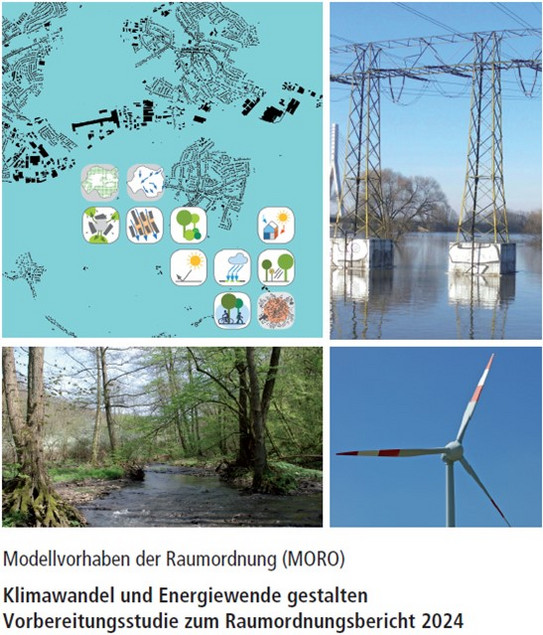
The thematically focused Spatial Planning Report 2024 focuses on the fourth guiding principle of spatial development. Against the backdrop of changing challenges and political objectives, the mission statements and action strategies defined in 2016 on the topic of "Shaping climate change and the energy transition" need to be reviewed, adapted to changing framework conditions and concretized. The basis for this is an analysis of the status quo of the relevant spatial conditions and infrastructures (geodata analysis) as well as the legal and political framework conditions with regard to climate protection, the energy transition and climate adaptation. Based on this, the strategies for action are to be expanded and the spatial models are to be mapped.
Concrete measures and solution strategies for conflict avoidance are to be identified on the basis of best practice examples and conclusions drawn for energy-oriented spatial planning.
Client: BBSR - Federal Institute for Research on Building, Urban Affairs and Spatial Development
Duration: 01.02.2022 - 31.10.2023
Project partners: Planning office agl Hartz Saad Wendl - Landscape, urban and spatial planning (coordination); plan+risk consult - Prof. Dr. Greiving und Partner; INZIN e. V. - Institute for the Future of Industrial Society; TafelmitKollegen KG, Agency for Communication
RES project management: Dr. Martin Schulwitz
The aims of the TransMiT project are to demonstrate and evaluate how urban development and water management aspects can be synergistically linked in the long term in neighborhood and infrastructure planning, taking into account an overall view of resources. To this end, different research approaches will be examined in practice in three existing districts that are characteristic of the system. The focus is on transformation-relevant technical and organizational aspects of the resource-optimized transformation of combined and separate drainage systems.
In the wake of more frequent heavy rainfall events, the regulatory requirements for flood protection of buildings and properties have become increasingly stringent in recent years. The aim of the sub-project at TU Dortmund University is to investigate roof surfaces with regard to their potential suitability for rainwater retention relevant to drainage and flood protection. The investigations include measurement surveys on the runoff behavior of the roof surfaces, their monitoring, evaluation of the results and the transfer to the selected urban quarters.
Duration: 04/2019 to 03/2022
Further information on the project: to the final report
Further information on funding: Federal Ministry of Education and Research (BMBF)
Contact: Prof. Dr.-Mathias Kaiser, Jana-Marie Storchmann
Other parties involved:
Institute for Urban Water Management and Waste Technology (ISAH)
Institute for Urban Water Management at TU Braunschweig (ISWW)
Institute for Infrastructure and Resource Management (IIRM)
Institute for Cartography and Geoinformatics (ikg)
Stadtentwässerung Hannover, Eigenbetrieb der Landeshauptstadt Hannover (SEH)
Landeshauptstadt Hannover, Fachbereich Umwelt und Stadtgrün (LHH - FB 67.10)
Stadtentwässerung Hildesheim (SEHi)
Stadtentwässerung Braunschweig GmbH (SEBS)
Wohnungsgenossenschaft Gartenheim eG (GH)
Spar- und Bauverein eG (spar + bau)
bpi Hannover
aquaplaner Ingenieurgesellschaft für Wasserwirtschaft, Umwelt, Abwasser
plan zwei Stadtplanung und Architektur
As part of the "Nexus Resource Conservation and Climate Protection" doctoral cluster, which is affiliated with the Resources Commission at the Federal Environment Agency (UBA), three doctoral projects were funded and carried out between July 2018 and December 2021 under the direction of Prof. Dr. Martin Faulstich. The three doctoral projects were funded during this period with funds from the Federal Environment Ministry's departmental research plan.
Doctoral project I, entitled "The Shape of Sustainability", was carried out by Mr. Dustin Jessen at the Folkwang University of the Arts in Essen and supervised by the co-chair of the UBA Resource Commission, Prof. Dr. Christa Liedtke, Professor of Sustainability in Design at the Folkwang University of the Arts and Head of Department at the Wuppertal Institute for Climate, Environment and Energy. This report takes up publications that have already been published, are planned or are in progress as part of doctoral project I.
PhD project II, entitled "Resource-efficient development of ICT infrastructure", was carried out by Mr. Florian Fiesinger at Clausthal University of Technology (TU) from 01.07.2018 to 31.08.2019. The work was scientifically supervised by the co-chair of the UBA Resource Commission, Prof. Dr. Martin Faulstich, and resulted in 3 publications[1]. Prof. Faulstich has held the Chair of Resource and Energy Systems at the Technical University (TU) Dortmund since 2020. The research project was continued from January 2021 with a focus on the "Resource requirements of the energy transition" by Ms. Charlotte Joachmisthaler at TU Dortmund University.
Doctoral project III was carried out by Mr. Thomas Kippes at the University of Augsburg and deals with the topic "Dissipation of functional metals". It was scientifically supervised by Prof. Dr. Armin Reller (Chair of Resource Strategy at the University of Augsburg). The dissertation is freely available as a digital publication on the Opus publication server of the University of Augsburg[2].
Client: Federal Environment Agency, Resources Commission (KRU)
Duration: 07/2018 to 12/2021
[1]Fiesinger, F.; Seelig, J.; Faulstich, M.: Dissipative Structure / Streams. In: CEC4Europe, 2018
(Online), pp. 1-5. www.cec4europe.eu/wp-content/uploads/2018/11/Chapter-2.5.1_Dissipativestructure-steams_Fiesinger_Seelig_Faulstich.pdf.
Fiesinger, F.; Greiff, K.: Material flow model of the ICT infrastructure in Germany. In: DGAW Deutsche Gesellschaft für Abfallwirtschaft e.V., Berlin (ed.): 9th Science Congress on Waste and Resource Management, March 14 and 15, 2019, Ostbayerische Technische Hochschule Amberg-Weiden. Conference proceedings, ISBN 978-3-903187-48-1, Innsbruck University Press, 2019, pp.105-110
Greiff, K.; Fiesinger, F.; Liedtke, C.; Faulstich, M.: C like Clever and Cycle - Without a Smart and Systematic Conception of the Metal Industry, Product Labeling and an Indicator System, Nothing Will Happen. In Lehmann, H. (Ed.): Factor X: The Nexus of Sustainable Development and Resource Productivity. The Nexus Approaches. Taylor and Francis, 2021. p. 262-274
[2] Available online at: https://nbn-resolving.org/urn:nbn:de:bvb:384-opus4-915587
The expansion of wind energy is a central pillar that should support the phase-out of fossil fuels. Around 28,000 wind turbines are currently installed onshore in Germany. Many of these turbines will have to be dismantled in the coming years. On the one hand, dismantling will be necessary because the subsidy period for turbines under the German Renewable Energy Sources Act (EEG) is coming to an end and, on the other hand, the technical service life of the turbines is limited. Based on the dates on which the plants were built, 2021-2030 will be the peak period for dismantling measures. Not least in view of the European Green Deal and the Circular Economy Action Plan, it is clear that the necessary dismantling must be carried out in a resource-efficient and environmentally friendly manner. The German government's Resource Efficiency Program III (Progress III) therefore also consistently states as a goal that the dismantling of facilities should be based on a sustainable and manufacturer-supported dismantling and recycling concept that does justice to the diversity of the facilities. The goal outlined in this way raises various legal, technical and organizational questions.
Initial foundations for answering these questions were developed in the research project "Development of a concept and measures for the resource-saving dismantling of wind turbines" (UBA-Text 117/2019). Based on the actual circumstances and the identified need for research, the tendered project is now intended to take further steps to ensure that the local licensing and enforcement authorities can support the dismantling and recycling process of wind turbines on a scientifically sound basis and thus ensure that people and the environment are protected and that the materials are primarily recycled in line with the objectives of the waste hierarchy.
The task of this research project is to develop a basis for guidelines in the form of an expert report. These are to be created subsequently and on the basis of this project, in order to enable a transnationally coordinated monitoring of the dismantling/recycling of wind turbines. To this end, this project will identify issues for which official monitoring makes sense and/or which should be regulated by binding requirements. Proposals for efficient and effective measures that can be taken by the authorities in the context of dismantling and recycling wind turbines will also be identified. The aspect of calculating the restitution payments (Section 35 (5) sentences 2 and 3 BauGB) and the accessibility of manufacturer information for the dismantling and recycling of wind turbines are to be considered in particular and assigned to individual work packages. It will be evaluated which information must be collected from manufacturers and secured by whom and how in order to ensure the environmentally sound dismantling of all wind turbines and storage technologies. The possibility of energy storage and the questions of manufacturer responsibility associated with the respective storage technology must also be considered. To this end, the development potential of various technologies in the field of wind energy, which electronic components and storage systems are already covered by existing legislation (e.g. WEEE, Directive 2006/66/EC, Battery Act, etc.) and which waste management requirements result from this.
Duration: 05/2021 to 08/2022
Client: Federal Environment Agency
Main contractor: Ernst & Young Law GmbH (EY Law)
Subcontractor: Ernst & Young Wirtschaftsprüfgesellschaft (EY WPG) & Chair of Resource and Energy Systems (RES)
Download study: Link


